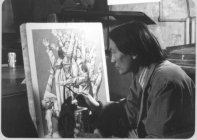 "The
Shadow of Dreams" at the Ciurlionis National Museum of Art, Kaunas,
Lithuania.
"The
Shadow of Dreams" at the Ciurlionis National Museum of Art, Kaunas,
Lithuania.
Dec.
21st 2001 to January 20th 2002.
Su Xinping is represented in Scandinavia by Foundation 3,14.
Su Xinping teaches at the Central Art Academy in Beijing. For enquieries contact Gallery 3,14.
"A
Vision of the Inner Spirit"
The
Lithographs of Su Xinping
by Nicky Combs
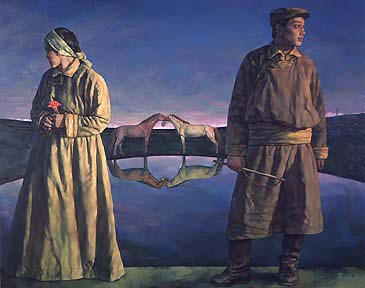
The
mysticism of qigong, desires revealed in shadow, travels through a dreamland
-- these esoteric elements populate the recent lithographic works of Su
Xinping. Su´s skilled hand captures his personal experience, his
own subjective take on a moment in time, and yet his works also open a
wider window onto contemporary Chinese society. The dramatic transformations
of the last two decades -- in economic life, in culture, in society and
politics -- are the forces that have shaped and informed Su´s artwork.
Resisting both the staid security of officially sanctioned art and the
fickle faddishness of the avant-garde, Su has forged his own way, creating
distinctive works marked with a reserved, introspective quality rare on
both the contemporary Chinese and international art scenes.
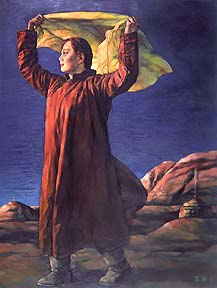 Su´s
graduate works were largely inspired by his time spent in Inner Mongolia:
Pastoral scenes of vast grasslands and timeless people, their movement
rendered with a restraint and control that blends them smoothly with the
simple landscapes of rolling hills. Su conveys a feeling of innocence
through facial expressions, individually calm and still, sincere in their
serenity. There is no obvious subjective meaning -- only the quiet expression
of a true moment.
Su´s
graduate works were largely inspired by his time spent in Inner Mongolia:
Pastoral scenes of vast grasslands and timeless people, their movement
rendered with a restraint and control that blends them smoothly with the
simple landscapes of rolling hills. Su conveys a feeling of innocence
through facial expressions, individually calm and still, sincere in their
serenity. There is no obvious subjective meaning -- only the quiet expression
of a true moment.
Moving away from nostalgia to more contemporary, more widely shared themes, in 1990 Su completed Dialogue, a motif he repeated in 1998. In the first version he has placed two figures facing one another in a mirrored exchange. At the time he created the work, Su Xinping remarked that its subjects were isolated from one another and were unable to communicate in any deep way; the figure is thus in a dialogue with himself. By opposing these figures -- one negative and the other positive -- he admits it is a sobering scene of meditation. He believes there is a sort of balance and harmony, a Taoist yin-yang complement. Contrast this with the 1998 print, also entitled Dialogue: In the more recent work, Su has applied color to the original black and white print. The sky is now a vibrant red, and the figures are smiling with rosy cheeks and red lips in a manner reminiscent of agro-utopian posters of the Cultural Revolution. Satire and humor have replaced the feelings of spirituality and loneliness that saturate the earlier work.
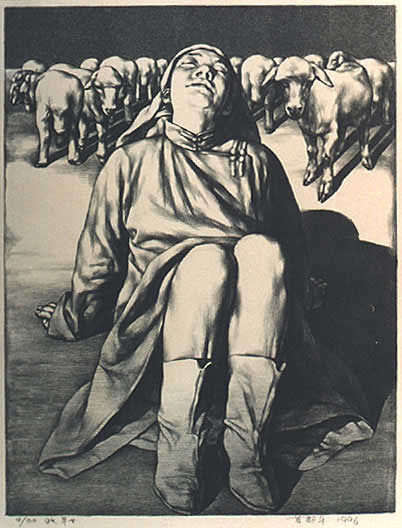
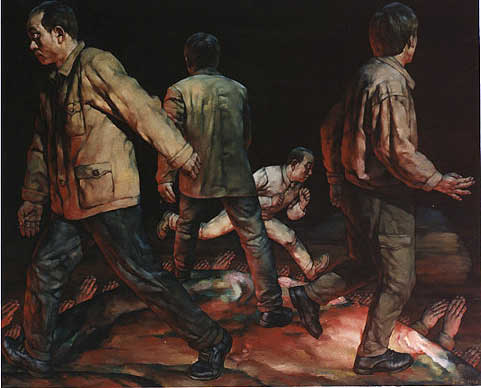
The Amadlozi Group was formed in 1961 and the members comprised Skotnes, Guiseppe Cattaneo, Cecily Sash, Sydney Kumalo and Edoardo Villa - the name chosen by Skotnes means "Spirit of our Ancestors". Works by members of this group manifested an essentially African influence. In 1965 Skotnes was invited to exhibit at the Grosvenor Gallery in London and since then has exhibited extensively at international venues. His first portfolio of colour woodcuts, published in 1970, while still a member of the Amadlozi Group, has been followed by numerous portfolios and in these Skotnes´ collaboration with the poet, Stephen Gray, has been particularly successful. Skotnes moved from Johannesburg to Cape Town in 1979, where he still resides.
The
clothing has changed from a Mongolian robe to the androgynous suit worn
by China´s past officials, the so-called "Mao suit." The
horizon has been reshaped, softened and blurred, lending the feel of spontaneity,
of levity.
While
he admits that the ´98 work expresses a certain cynicism, Su Xinping
insists that at a more fundamental level the work is an exploration of
a new approach to lithography, incorporating the technique of ink and
wash painting. Although the theme is still of internal dialogue, he has
lifted some of the seriousness that marked many of his earlier works.
At the close of the last decade, Su Xinping´s own internal dialogue
might be construed as one between a dark cynicism and a buoyant levity.
It was during the early 1990s that Chinese artists recognized that the
idealism, freedom and enthusiasm they enjoyed in the 1980s was not without
limits. Su acknowledges that these feelings permeated his works. Challenged
by the conditions of the day, Su´s struggle to give voice to his
identity in a difficult environment is evident in the spiritual nature
of his work. Rather than create something kitsch, shocking, or commercial,
Su´s response was to create works that explore his personal, individual
reactions to China, such as the earlier Dialogue.
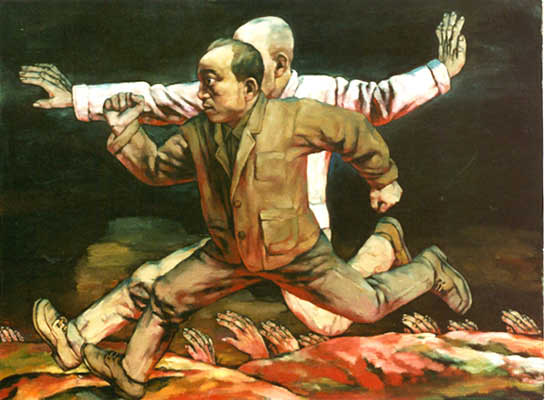
During the mid-1990s Su Xinping graduated to new themes that took on social issues and concerns more directly. In one of his most expressive series, Sea of Desire (1994), Su alludes to the pressure that rapid economic development places on individuals. As some individuals acquired considerable wealth, they touched off a revolution of rising expectations -- expectations not, of course, fulfilled in all. Sea of Desire sought to express the frustration he and others like him felt at the time: In this series of 10 plus works he exaggerated these feelings of unsatisfied material desire. The first works in the series portray the tension, the pressure, the stress of Chinese economic life through images of people diving into and swimming in waves of hands. Su portrays the pain and sorrow his own desires wrought: In a self-portrait, he holds his head in his hands as the sea of unattainable desires surrounds him. Su conveys this feeling through graphic rendering of a progression of emotions toward the dislocating changes of the 1990s. He begins with a chaotic representation that gives way to a portrait of himself in a state of depression, and finally ends with a few figures running lightly through the hands.
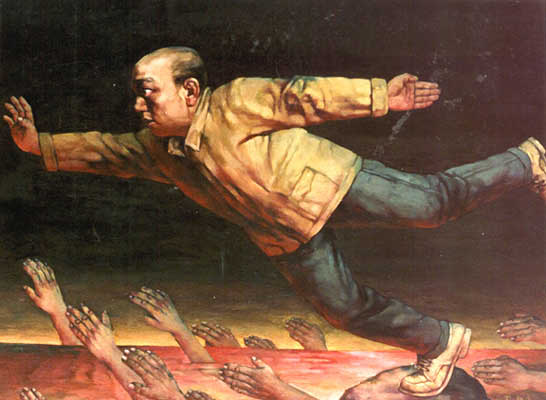
Today
Su Xinping believes that a social reconfiguration has been completed and
people are more happy and stable. He continues to provide eloquent visual
portrayals of the social changes occurring within the past two decades
in China. His personal interpretations beg the viewer to understand his
individual suffering or joy of experiences in contemporary China.
Su Xinping´s latest works are once again rendered in black and white and continue to explore a new language of printmaking. He is finding more inspiration from ink and wash technique, infusing his works with a simplicity which in turn increases the depth of his work. Each work of this new series is thought-provoking; Su still communicates on a personal level. Su Xinping´s works provide an intimate language marked by his inner spirit, affording a look into his emotions and a path to consider our own.